
Station Name: WHITWORTH[Source:
Alan Young]
Whitworth Station Gallery 2: 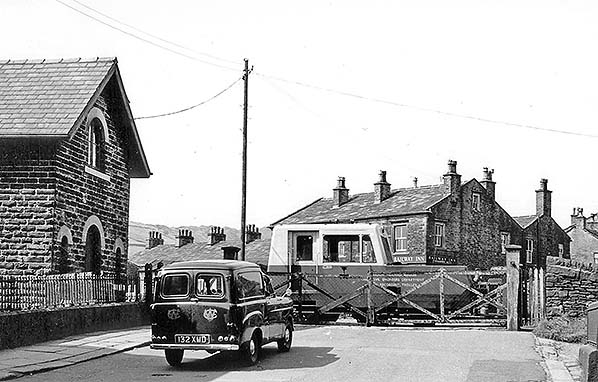
Tonge End (Tong Lane) crossing was midway between Whitworth and Facit stations on the Rochdale-Bacup line. The attractive two-storey stone building with its overhanging roof and arched openings is the crossing keeper’s house (now demolished). In this north-westward view on 28 August 1961 a self-propelled Matisa track inspection trolley is no doubt looking for 'drop joints' and monitoring the general state of the track. The rail vehicle is one of 13 track geometry recording trolleys bought by British Railways from Matisa of Switzerland between 1957 and 1967. They worked over all passenger lines and selected freight-only lines at intervals of between three and twelve months depending on the line classification. The trolley recorded directly onto a paper roll at up to 15mph on plain line. When not recording, it could run under its own power at up to 40 mph. They became known also as the Neptune trolleys after a computer system was added to complement the paper trace.
Photo by Ian G Holt 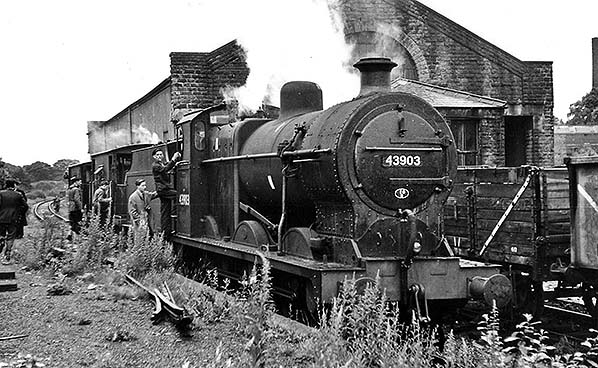 On 21 July 1962 a group of enthusiasts is on the overgrown platform at Whitworth station, one week in advance of the ‘Salford Hundred Railtour’. In this southward-facing view Whitworth goods warehouse is behind the locomotive with its pair of brake vans. The building is of stone but with a wooden screen forming its eastern wall. Although able to accommodate two sidings it seems that only one loop ever entered it. The loco is a Fowler-designed 4F 0-6-0, built by the Midland Railway in April 1920 at Derby works. Numbered 3909 in LMS ownership the ‘4’ prefix was added by British Railways. No.43903 was withdrawn from 16C, Kirkby-in-Ashfield shed, on 9 May 1964 and cut up by Slag Reduction Co Ltd, Ickles, Rotherham in December 1964.
Photo by Ian G Holt 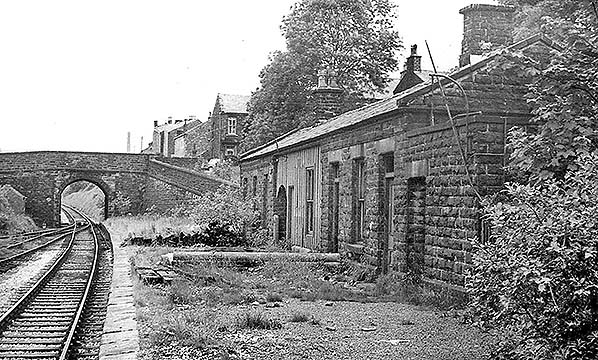 Whitworth station looking north circa 1962; the Triumph Herald (introduced in 1959) parked at the top of the station approach track is a guide to the age of the photo. At this time the line remains in use as far as Facit, about a mile further on, but the remainder of the line to Bacup has been relegated to a wagon storage facility. The platform is reverting to nature but the building still looks in a reasonable state of repair. The three curved pipes springing from the building formerly had gas lamps attached to them. The wooden screen midway along the building encloses what was originally a recessed waiting area. Hall Street bridge was built only for a single track, perhaps surprising as when the line was planned and constructed in the late 1860s the area’s population and industrial status were rising and passive provision might have been made for increasing the line capacity; significantly the goods loop and siding split from the main line at the earliest opportunity this side of the bridge. When the line was extended beyond Facit in 1881 double track was provided.
Photo from John Mann collection 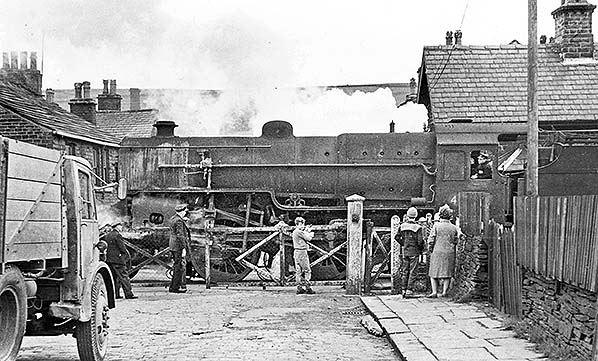 A northbound weedkilling train is negotiating Tonge End crossing between Whitworth and Facit on 30 April 1963. Hauling the train is No. 42750, a Hughes-designed ‘Crab’ 2-6-0 built in June 1927 at the LMS Crewe works. In August 1963 she was withdrawn from 39A, Gorton shed, to be cut up at Wards, Broughton Lane, Sheffield, in May 1964.
Photo
by Ian G Holt
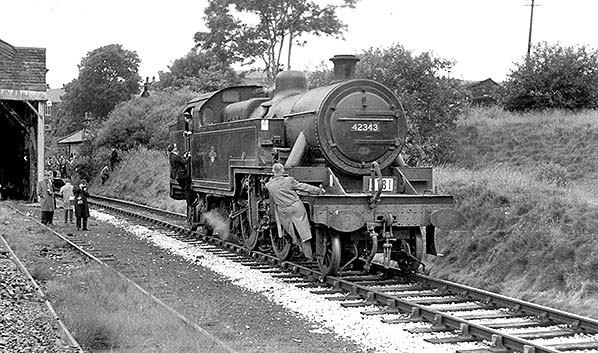 Looking north at Whitworth station on 7 August 1965. The goods warehouse is on the far left and the passenger station in the background. Regular passenger services ceased in 1947 but on this day the Locomotive Club of Great Britain ‘Middleton Branch Brakevan Tour’ is at Whitworth, the northern terminus of the truncated Rochdale-Bacup line. Enthusiasts (including the cameraman who took this photo) have wandered onto the trackbed or scrambled up the cutting to obtain vantage points, while others throng the platform, and one has chosen a precarious position on the loco. The train consisted of nine brake vans but on its northbound journey it stalled on the 1 in 59/62 gradient north of Wardleworth, and the loco propelled its load back to Wardleworth where five of the vans were detached. The four remaining vans completed the journey to Whitworth and back to Wardleworth, where the train was re-formed to the full nine vans.
Photo by Ian G Holt  Looking south at Whitworth station on 7 August 1965. The wooden eastern screen wall of the goods warehouse is clearly visible. Regular passenger services to Whitworth ended in 1947 but here a rail tour visits the station, and the south end of the old platform provides a safe place for people of all ages – and not just males! - to admire the locomotive. The LCGB ‘Middleton Branch Brakevan Tour’ provides an opportunity for travel on what is left of the Rochdale-Bacup line; since 1963 Whitworth has been the northern terminus, when the mile beyond to Facit was abandoned. One of the four brake vans, seen here, which travelled from Wardleworth to Whitworth has a large complement of passengers. The train set out with nine vans but had to abandon five of them at Wardleworth, the first station out of Rochdale, as the load was too great for the loco to haul up the gradient north of the station. The loco seen here, No.42343, is a Fowler-designed 4P 2-6-4T built by the LMS in April 1929 at Derby works. She was withdrawn from service on 30 October 1965, shortly after this tour, leaving 13A, Trafford Park shed, to be cut up at Cashmores, Great Bridge the following month.
Photo by Ian G Holt  The LCGB ‘Middleton Branch Brakevan Tour’ is seen at Whitworth on 7 August 1965, at this time the northern terminus of the Rochdale-Bacup line. Since 1947 the branch has been used only by freight trains, plus the occasional enthusiasts’ excursion. The platform and station building are still in place (left) and the goods warehouse is intact with a loop still passing through it. The loco is a Fowler-designed 4P 2-6-4T built by the LMS in April 1929 at Derby works. She was withdrawn from service on 30 October 1965, shortly after this tour, leaving 13A, Trafford Park shed, to be cut up at Cashmores, Great Bridge the following month
Photo by Ian G Holt 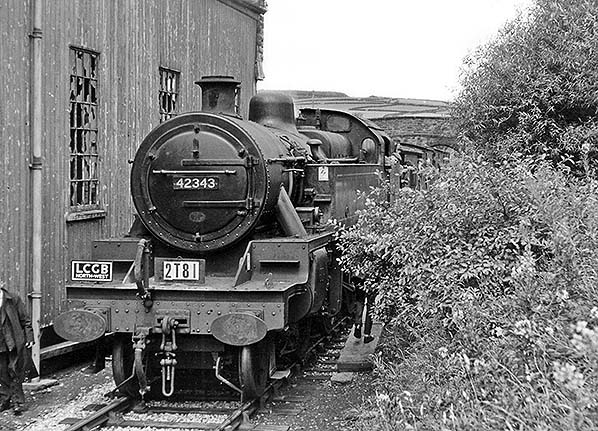 Fowler 4P 2-6-4T stands at the platform ramp of Whitworth station on 7 August 1965. The timber east wall of the otherwise stone-built goods warehouse is to the left of the locomotive, its windows having suffered from vandalism. The loco is hauling the Locomotive Club of Great Britain (North-West Branch) ‘Middleton Branch Brakevan Tour’.
Photo
by Ian G Holt
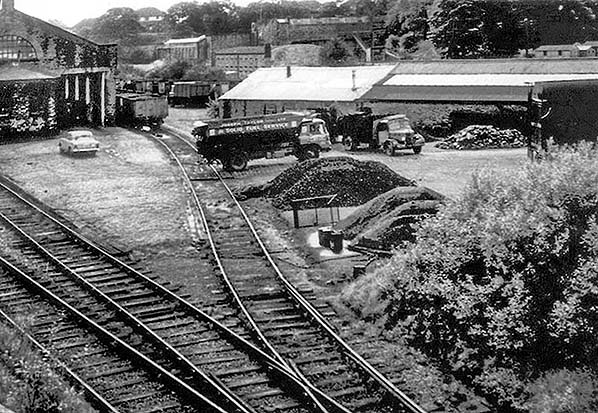 Joseph (Joe) Taylor’s coal business operated from the station yard at Whitworth. This view, looking south from Hall Street bridge no earlier than 1959, includes the goods warehouse and sidings with some coal wagons in place. The Bedford TK lorry (a type introduced in 1959) carries the coal merchant’s name. The lorry on the right is a Bedford K, M or O series.
Photo from Whitworth Historical Society 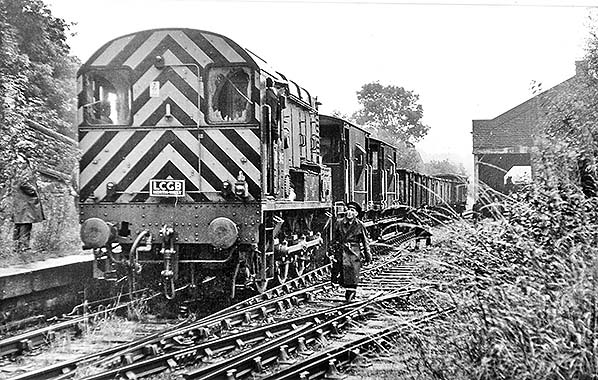 On Friday 18 August 1967, a final LCGB tour travelled up to Whitworth, on a train comprising three brake vans and several wagons hauled by D3845. This view is looking south, with the platform to the left and goods warehouse, right. The final freight train ran the following day and the line closed on 21 August. By the end of the year the rails had been removed from the entire route. Photo by Ian G Holt
|

 Home Page
Home Page